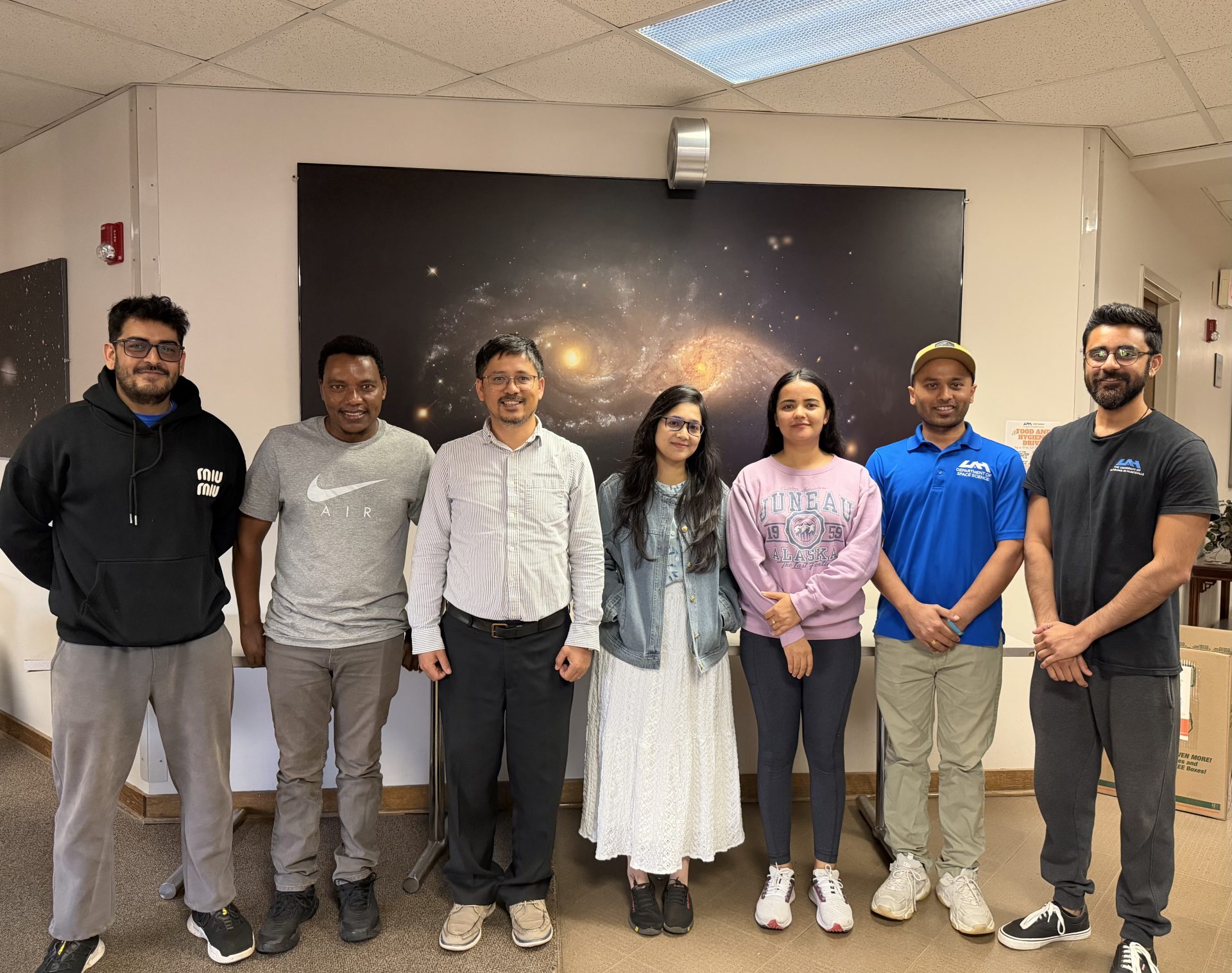
A novel, innovative approach to teaching his first doctoral-level introductory fluid and space plasma turbulence class by new assistant professor of space science Dr. Laxman Adhikari at The University of Alabama in Huntsville (UAH) has resulted in publication this month of a new framework for the field of space physics to understand the turbulence properties of the solar wind in the respected Astrophysical Journal (ApJ).
Hired as faculty in 2024 as part of a continuing $20 million National Science Foundation grant managed at UAH called Future Technologies & enabling Plasma Processes (FTPP) and its predecessor grant, Dr. Adhikari obtained his doctorate at UAH in 2015. From the planning stage, he set up his inaugural teaching class to do class research and to write a class paper for potential publication.
“I wanted to make this class unique and worth it for the students and for me,” says Dr. Adhikari. “One way was to publish a paper in a peer-reviewed journal. This was a motivation for conducting a research project, a project that was completely separate from the students’ individual final research projects, with the students as a class writing up the manuscript and submitting it to the Astrophysical Journal.”
The class was taught in spring 2025. The resulting paper by Dr. Adhikari, his seven-member class and additional coauthors, entitled “Reynolds Number and Viscosity in the Solar Wind,” was accepted for November’s ApJ.
“The aim was to educate students by involving them directly in the research using ideas that came up from class discussion and through hands-on experience,” says Dr. Adhikari. “Beyond the research experience, this also familiarized them with the processes involved from manuscript submission to publication. They gained insight into how to address reviewers’ comments.”
The paper investigates the Reynolds number, a key parameter used to distinguish turbulent flow from laminar flow, as it relates to viscosity in the solar wind plasma between the sun and the Earth.
“These parameters are the important indicators of turbulent behavior, such as a high Reynolds number and low viscosity being characteristic of turbulent systems,” he says.
“Our results show that with decreasing distance from the sun, the turbulent viscosity of the plasma decreases, while the turbulent Reynolds number increases, indicating that the solar wind plasma becomes increasingly turbulent closer to the sun. Additionally, we show throughout the region between the sun and the Earth, that the turbulence scaling laws in the inertial range control the Reynolds number and viscosity in the solar wind.”
Class Idea
The idea and title of the research project came up during class discussion of the Reynolds number and viscosity in fluid.
“We decided to apply this idea to the solar wind plasma,” Dr. Adhikari says. “However, we first had to reformulate the theory for the Reynolds number and the viscosity that incorporates several turbulence scaling laws in the inertial range.”
The class reviewed the new approach together and applied it to the measurements of the Parker Solar Probe and Solar Orbiter spacecrafts.
“I first derived the theoretical framework to estimate the Reynolds number and viscosity in the solar wind, and asked the class students to review and provide their comments,” he says. “After we all agreed on the theoretical framework, we decided to use this for the measurements of the Parker Solar Probe and Solar Orbiter spacecrafts.”
FTPP Regional Introduction to Plasma Physics intern Lucien Treville, who worked with Dr. Adhikari as a summer intern in a program that also used Parker Solar Probe data, provided Dr. Adhikari with Parker Solar Probe magnetic field and plasma data for this project. The research “was not an easy job,” Dr Adhikari says.“Similarly, the class students helped me to improve the results and the manuscript by providing comments.”
Publication in ApJ was the crowning achievement for their work and also conferred skills the students should find beneficial in future careers.
“They are the co-authors of the paper, which is an important step for them,” he says, noting that besides the students, other co-authors’ help was crucial. Class co-authors are Ashutosh Giri, Monika Karki, Prashant Baruwal, Prashrit Baruwal, Rubaiya Khondoker Shikha, Bigyan Mainali and Dessalegn Kenno.
“In addition, this helped the students to familiarize themselves with the Parker Solar Probe and Solar Orbiter data, a theory for the estimation of Reynolds number and viscosity, an experience of writing a scientific paper and a process of publishing a paper in a scientific journal. This is important knowledge that everyone will need in their scientific career.”
Student Insights
The class helped her understand how the theory they studied applies to real observations and physical processes in the solar wind, says Monika Karki, a student supported through an FTPP program that funds graduate students doing research in plasma and space physics.
“I learned how turbulence works in ordinary fluids and in magnetized plasmas like the solar wind,” she says. “One of the most valuable parts was the hands-on project, where we analyzed the real solar wind data and applied the turbulence theories we learned in class.”That gave her practical experience in handling spacecraft data, doing statistical analysis and interpreting results.
“Overall,” Karki says, “I must say this class taught me how to link mathematical concepts with actual observations, skills that I know will be very useful in my future science career.”
That the class culminated with publication was a proud moment for Dr. Adhikari.
“Overall, the students worked very hard and also enjoyed getting this research project published in the Astrophysical Journal,” he says. “I was pleased because this was the first time we submitted a research class project in the form of a manuscript to a peer-reviewed journal. This experience will inspire me to use a similar, but improved approach in my future classes.”